Let’s introduce our Philips Hue lights to Siri and HomeKit. We will look into the basic steps and additional tricks to get the most out of our setup. Furthermore, we will look into Siri Shortcuts and how they can help us to create our own voice commands, which can do much more than just setting a scene.
If you have not set up your Philips Hue lights in the Philips Hue app yet, please have a look at Philips Hue: A Smarter Setup for Your Smart Lights.
Please note, HomeKit and Philips Hue app Siri Shortcuts are only supported on the Generation 2 (square) Philips Hue bridge.
Estimated reading time: 15 minutes
Table of contents
HomeKit, Siri and Shortcuts – What is this all about?
So, you have your Philips Hue app set up and configured and you are looking now into using Siri to control your Philips Hue lights with your voice, and automating them with HomeKit.
Let’s first get an overview of the different Apple concepts we will meet in this post. As the features are overlapping, it might confuse you to the point, that you overlook some of the options you have with your Apple setup.
Who (or what) is Siri?
Siri is Apple’s voice assistant. You might know her from other features on your iPhone, iPad, HomePod, iMac/MacBook, AppleTV, AppleWatch and AirPods. To access your Philips Hue lights, Siri will look for them in your home data.
What is Apple’s HomeKit?
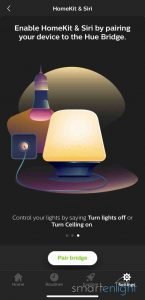
Apple HomeKit is Apple’s smart home framework. Your home data is basically a HomeKit database of all your HomeKit smart home accessories and defines the smart home “commands” Siri will understand. You can access your home data in HomeKit with the Apple Home app on your iPhone, iPad, and iMac/MacBook.
If you want to control or monitor your home, when you’re away or automate your accessories to do what you want, when you want, you’ll need a dedicated HomeKit Hub. This is a feature of the HomePod, Apple TV (HD or 4K) or iPad. Philips recommends to set up a HomeKit Hub anyway. You can find a link to Apple’s how-to in the “More Information” chapter at the end of this post.
Now I have to use two apps?
The Philips Hue app will synchronize all your lights and rooms to Apple’s HomeKit. You can still use the Philips Hue app to control and automate your Philips Hue lights. If you own other HomeKit devices, like smart lights from another manufacturer, cams, locks, outlets, thermostats, etc. you can create scenes and automations in the Apple Home app to control all of your devices to work together.
What are Siri Shortcuts?
Let’s have Siri herself explain Siri Shortcuts in our AI-News Special:
To summarize for Philips Hue: Shortcuts are an automagical feature which silently learns from you in the background and suggests useful shortcuts. The shortcuts surface in the spotlight search and on your lock screen. Applications like the Philips Hue app donate App Shortcuts to Siri, so she can learn when you usually activate a scene or turn your lights on or off in the Hue app and suggest these actions at the proper time.
If you are completely new to Siri Shortcuts (or HomeKit), watch Siri’s 1 minute explainer cartoon from our post Minority Report: A Siri, HomeKit, Home App and Shortcuts Overview:
Additionally, you can define the voice command for a Siri Shortcut yourself. With Apple’s Shortcuts app, you can combine your Philips Hue Siri Shortcuts or HomeKit scenes with other actions, like playing the right music or sending a message “Dinner ready” to your family. All this with just one voice command, which you can define by yourself.
In this post, we will go through all the different options:
- from setting up your Philips Hue lights in HomeKit and all the HomeKit Siri voice commands you can use with this setup,
- to defining our own Siri Shortcuts from the Philips Hue app, and
- finally, creating a Shortcut in Apple’s Shortcut app, which combines multiple actions.
1. Philips Hue – HomeKit Setup
Allow the Philips Hue App to access HomeKit
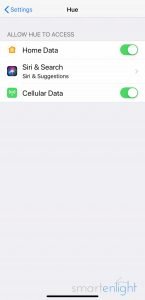
Chances are, that already when you launched your Philips Hue app for the first time, it asked you, whether you’d like to allow Hue to access your home data. Since this might have happened quite some time ago, let’s check quickly whether you clicked “OK”.
In the Apple Settings app, scroll all the way down to the Philips “Hue” app and tap on it. The “Home Data” switch needs to be on (green).
Pro-Tip: If you swipe down on the first page of the Settings app, you’ll find a search bar, which comes handy, if you cannot remember where to find a particular iPhone/iPad setting.
Pair your Philips Hue Bridge with HomeKit
To pair your Philips Hue bridge with HomeKit, open the Philips Hue app “Settings” and navigate to “HomeKit & Siri”.
When you do this for the first time the app will search for your Hue bridge. Tap on “Pair Bridge” and select your “HomeKit” home or create a new one, if you have not already. When the HomeKit scanner pops up, scan the HomeKit code on the back of your bridge.
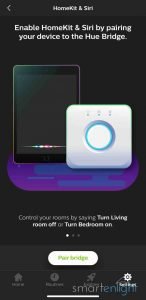
You will receive a message, that the HomeKit rooms do not match the rooms in your Philips Hue app. Tap “Update rooms” to copy your rooms to HomeKit.
Wait for a couple of minutes, as the HomeKit update requires some time and then verify in the Apple home app, that all your lights and rooms have been copied over.
Your Philips Hue accessories, like motion sensors, dimmer and tap switches, will end up in the HomeKit “Default Room”. You need to force/long tap on them to go into the settings and assign them to the rooms they belong to.
Create HomeKit Scenes
To create scenes for HomeKit, tap the “Scenes” menu under the “HomeKit & Siri” section and then the button “new scene” on the top left. Give every HomeKit scene a unique name e.g. “office concentrate” (or “concentrate in office”, if you prefer the Alexa style) and specify the room(s) and the Hue scenes.
If you’ve created different rooms for different areas of e.g. your living room, you can now group up to four scenes into one HomeKit scene. This way you can control the areas individually and altogether with their own HomeKit scenes.
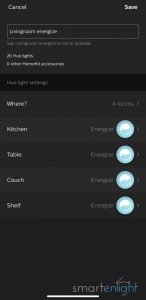
Dependent on how many scenes you would like to control, this process can take a lot of time, you can only speed it up by using Siri dictation for the names (pauses between multiple words help with recognition). But finally, you can control your scenes with Siri.
Note, that Apple’s HomeKit currently supports only up to 100 scenes per home.
Multiple Philips Hue Bridges Warning!!!
You will need to repeat the pairing, synching and scene creation for every Hue bridge you’d like to add to HomeKit.
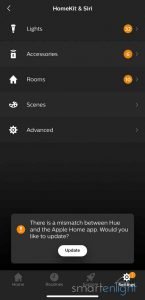
Bug-Note: There is currently a nasty bug in the HomeKit synchronization, which will continuously ask you to update the rooms and scenes. DO NOT CLICK ON UPDATE, as you will overwrite the scenes of your other bridges and will need to start from scratch!
Pro-Tip: Always check in the Apple Home app and with the voice commands below, that your scenes for all bridges are working. Once you are done, you can get rid of the annoying “Would you like to update?” message by uninstalling and reinstalling the Philips Hue app, and pairing to your Hue bridges. You won’t lose any settings, and the Philips Hue app will treat your HomeKit scenes as “created by another app” and stop bugging you.
Grouping Rooms into HomeKit Zones
Philips released an update to support “Zones” as another, more flexible grouping concept along with rooms. Alexa and Google are already importing Philips Hue Zone scenes, but lack currently other Zone control, like on/off, dimming and colors. Zones are currently completely missing in the “HomeKit & Siri” settings and we also cannot create HomeKit scenes based on Philips Hue Zone scenes.
This shall not worry us, as we can group our rooms into a HomeKit “zone”. To create HomeKit zones for e.g. floors, like upstairs or downstairs:
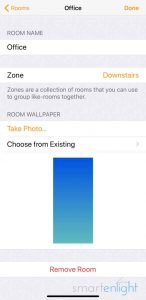
- open a room in your Apple Home app
- tap on the “edit” button at the top right
- tap on the little arrow which pops up next to the room name
- In this well-hidden room settings page, you can now specify the HomeKit Zone.
Finally! Apart from being able to control your lights with your voice, you now have a fully configured Apple Home app with all your rooms, lights and scenes from Philips Hue.
Automating HomeKit Scenes
With HomeKit schedules in the Apple Home app, we can control accessories and scenes at specific times. We can specify the time of day, the weekdays and whether somebody, who or nobody should be at home.
We use HomeKit schedules to synchronize our Philips Hue lights with HomeKit lights from other manufacturers.
But HomeKit gives us more options, than just the automations based on schedules:
- We can additionally switch HomeKit Scenes when (specific) people arrive or leave.
- We can use HomeKit Devices to trigger HomeKit scenes. This could be the Philips Hue Dimmer and Tap, or any other HomeKit switch or remote, like the Nanoleaf Remote.
- And last but definitely not least, we can use HomeKit sensors to trigger Philips Hue scenes. Think of motion or contact (door/window) sensors, smoke detectors, and security/occupancy sensors.
All these options can include time windows and people specific presence settings.
HomeKit Voice Commands
Voice Commands for turning Philips Hue lights On / Off
- Hey Siri, lights!*
- Hey Siri, turn off the bedroom lights!
- Hey Siri, turn off all lights, except for bedroom =)
- Hey Siri, turn off upstairs
- Hey Siri, turn on the Go lamp in the Dining room
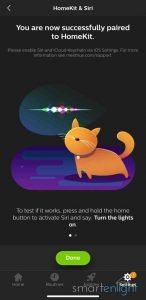
*Note: If you omit “on/off” when saying “switch” or “change” or “lights”, Siri will switch the lights individually from the current state to the other.
Pro-Tip: Siri understands many alternatives! Just pick the ones, which work best for you!
Hey Siri, switch / change / make / set / turn / activate / deactivate (on/off)
[ all/my, (the) LIGHTNAME / (the) ROOMNAME / (the) ZONENAME / (the) LIGHTNAME in/at (the) ROOMNAME] (light(s)) / (lamp(s)) (go) (on/off).
Voice Commands for setting Philips Hue Scenes
- Hey Siri, office concentrate
- Hey Siri, activate office energize
- Hey Siri, set couch relax
Pro-Tip: Siri, will also understand many alternatives like
Hey Siri, (switch / change / make / set / turn / activate / deactivate) (on)
[SCENENAME] (on)
Voice Commands for setting the Philips Hue Brightness
- Hey Siri, office 80
- Hey Siri, dim office
- Hey Siri, make the kitchen brighter
Pro-Tip: You can also use many of these alternatives:
Hey Siri, (switch / change / make / set / turn / activate / deactivate) ((the) brightness of)
[all/my, (the) LIGHTNAME / (the) ROOMNAME / (the) LIGHT-NAME in/at (the) ROOMNAME] (light(s)) / (lamp(s)) (brightness)
(to) x (percent) / darker/brighter / more/less dark/bright
Hey Siri, dim (down) / brighten (up) ((the) brightness)
[all/my, (the) LIGHTNAME / (the) ROOMNAME / (the) LIGHT-NAME in/at (the) ROOMNAME] (light(s)) / (lamp(s))
(brightness) (by x (percent))
Voice Commands for setting Philips Hue Colors
- Hey Siri, office Air Force Blue
- Hey Siri, set the office desk to the color asparagus
Pro-Tip: You can also use many of these alternatives:
Hey Siri, (switch / change / make / set / turn / activate / deactivate)
[all/my, (the) LIGHTNAME / (the) ROOMNAME / (the) LIGHT-NAME in/at (the) ROOMNAME] (light(s)) / (lamp(s)) (to (the color)) [COLOR-NAME]
Note: COLOR-NAME is not documented, but many color names from here are supported.
Voice Commands for setting the Philips Hue Color Temperature
Unfortunately, Kelvin are currently not supported. Philips suggests saving your favorite color temperatures as scenes.
2. Creating Siri Shortcuts in the Philips Hue App
If we are not so much into HomeKit, or just would like to customize the Hue scene commands, we can create Siri Shortcuts:
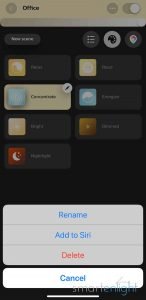
- In your Philips Hue app, tap on a room
- Tap on the Palette to open your scenes
- Tap on a scene and then on the little pencil icon which pops up
- Select “Add to Siri”
- Tap on the record button and say your custom phrase, e.g. “Let’s work!”
Hey Siri, let’s work! will set the scene!
Note, it seems there is currently a little bug, as Siri will double confirm: “Done. Office is set to …”
3. Creating Siri Shortcuts in the Apple Shortcuts App
Springtime, BBQ time! The steaks are ready, time to set the perfect outdoor dinner scene, play our favorite playlist and notify the family to hurry up. It can be as easy as: “Hey Siri, BBQ ready!”
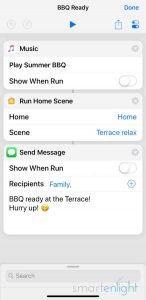
- Open your Apple Music App and start your favorite BBQ playlist (we are using here an Apple-curated playlist, like “Play Summer BBQ”).
- Open your Shortcuts app and click the “+” to create a new Siri Shortcut.
- Type “music” into the search bar.
- At the top of the list under Siri Suggestions, you will find “Play …” however your BBQ playlist is named. (As you see, we launched our playlist only once and now it appears as Siri Suggestion in our Shortcuts app) Just tap on it!
- Now let’s add the HomeKit scene: Type in “Home” into the search bar, at the bottom of the list and you will find “Run Home Scene”, tap on it.
- Click on “Choose” in the newly added Run Home Scene action. Tap on your Home in the list.
- Tap “Choose” and select the HomeKit scene (here “Terrace Relax”)
- Type “Message” into the search bar, at the bottom of the list and you will find “Send Message” under “Sharing”, tap on it.
- Add your family to the recipients
- Type your persuasive message
- Almost done! Tap on the settings icon on the top right (underneath “Done”)
- Let’s give this shortcut a name, e.g. “BBQ ready”
- Finally, let’s teach Siri our new voice command. Click on “Add to Siri.”
- Tap the record button and say: “BBQ ready”
- Click 3 times “Done” in the upper right corner! Close the app and we are finally done!
Pro-Tip: When on HomePod, the Shortcut will be executed from the iOS device you’ve used to set up your HomePod. You need to be on the same WiFi and have the personal requests enabled in the Apple Home app HomePod settings. In a family environment, it’s best to use a family iPad to setup your HomePod, so that the Siri Shortcuts also work, when you are not at home.
Conclusion
HomeKit and Siri let us import our Philips Hue room settings. We need to recreate the scenes in the Philips Hue app to access them with Siri. Sadly, there are currently bugs in the synchronization between HomeKit and the Philips Hue app, which make the setup of multiple bridges tricky. Philips Hue Zones are currently completely missing in the HomeKit & Siri support.
Still, Siri is obviously the oldest and wisest of our assistants. She handles multiple bridges and Philips Hue accessories as HomeKit triggers, and also supports additional ways of grouping our devices to make controlling them easier.
I hope you’ve enjoyed this post! If you have questions or want to share your ideas and experiences with Philips Hue and Siri, please leave a comment below!
Happy Siri Hue!
P.S. You can find more Siri posts here: Apple Siri
For a comparison to Alexa and Google, please see: Philips Hue: Who will win, Siri, Alexa or Google?
Apple: Set up your HomePod, Apple TV, or iPad as a home hub
Apple: Reset HomePod (in case you want to set it up with an iPad)
Apple: Your home at your command (HomeKit overview)
Philips Hue: “Siri, turn on the lights” (HomeKit overview)

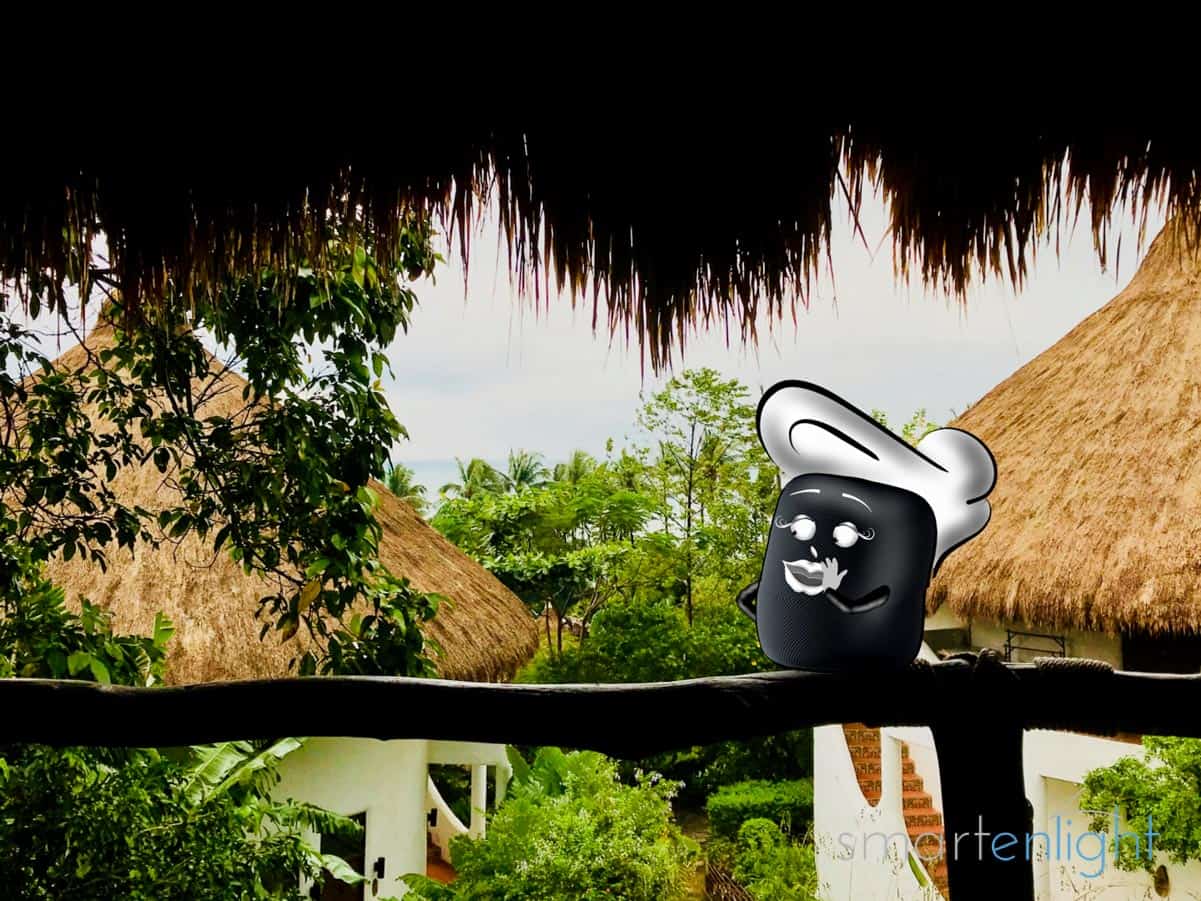


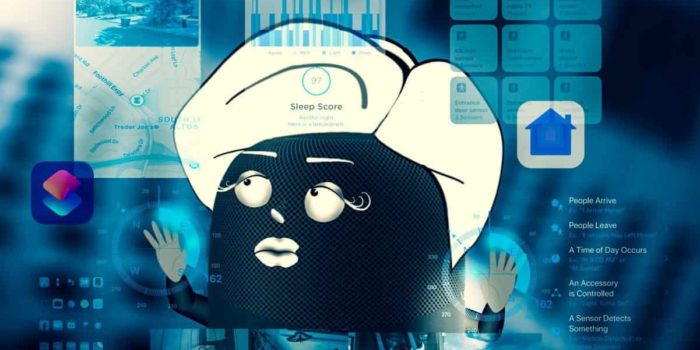
Ím trying to add a scenario from Nanoleaf AND Hue to HomeKit, but somehow every time I try either some random lights from the Hue turn bright white (and not colored like in the scenario) or the dynamic Nanoleaf scene turns bright white. Is there a bug or some workaround you can recommend?
The Nanoleaf HomeKit scenes are synched via Nanoleaf Cloud through the Nanoleaf app. For Philips Hue, you have to create the HomeKit Scene in the Hue app. You end up with 2 separate HomeKit scenes in the Home app, which should work independently of each other. You can:
– assign both scenes to e.g. 1 button on a Hue dimmer in your Apple Home app
– combine the scenes in a HomeKit automation (time of day, sensor, location)
– combine the scenes in 1 Siri Shortcut (Control Home action) – this is 1 voice command which can run as many scenes as you wish, but will run from your iPhone rather than the HomeKit hub
– combine the scenes in personal automations in the shortcuts app (e.g. when you charge your phone, put it near a NFC tag, and many more triggers, you can find in the shortcuts app / automations / create personal automation)
Hope this helps!
how do I know what scenes I have set up with Siri? how do I see these scenes. EX i create a shortcut & it tell me the shortcut already exists. I want to remove it. I do so & it tell me the same thing. how do I complete know what scenes are linked with Siri?
Apple’s home app lists “all scenes” which relate to accessories assigned to a room. Just open a room and you should be able to swipe through the scenes on top of this room. On the other hand, when you create a Shortcut and you select the “control home” action, you should also find a list of “all HomeKit scenes”.
In case HomeKit accessories controlled by a HomeKit scene are removed, neither the Shortcuts app nor the Home app will display the scenes for them, since they are now empty scenes, controlling nothing. Still, they are there hidden in HomeKit.
I’d suggest to install a HomeKit 3rd party app, e.g. “Eve for HomeKit” (free in the App Store) which will also display empty scenes. You can then delete those empty scenes from there.
Hope this helps!
Added the current state of Philips Hue Zone support (in short: it’s completely missing!)
Huge Update! Added Siri Shortcuts and HomeKit tips.
Here are some German Siri / Philips Hue commands:
AN/AUS:
Beispiele:
– Licht an
– Schalte Schreibtischlampe ein
– Schreibtischlampe im Office deaktivieren
Alternativen:
– Hey Siri, ( schalt(e) / setz(e) / stell(e) / mach(e) ) (die/das/alle) Lampe(n) / Licht(er) / [LAMPENNAME] ((in/im/auf/am) [RAUMNAME]) an/ein/aus/ab.
- Hey Siri, ( (die/das/alle) Lampe(n) / Licht(er) / [LAMPENNAME] ) ((in/im/auf/am) [RAUMNAME]) an/ein/aus/ab – schalten/machen/stellen / aktivieren/deaktivieren.
SZENEN:
Beispiele:
– Office Lesen
– Aktiviere Office Konzentration
Alternativen:
– Hey Siri, (setz(e) / stell(e) / aktiviere) [LICHTSZENE].
HELLIGKEIT:
Beispiele:
– Office 80
– Mach die Schreibtischlampe um 20% heller
– Dimme die Schreibtischlampe im Office um 40%
Alternativen:
– Hey Siri, ( ändere / setz(e) / stell(e) / mach(e) / dimm(e) / erhelle ) (die/das/alle) Lampe(n) / Licht(er) / [LAMPENNAME] (in/im/auf [RAUMNAME]) (auf) x (Prozent) / (noch) heller/dunkler / um x (Prozent)
FARBEN:
Beispiele:
– Office blau
– Ändere die Schreibtischlampe im Office auf Grün
Alternativen:
– Hey Siri, ( änder(e) / setz(e) / stell(e) / mach(e) ) (die/das/alle) Lampe(n) / Licht(er) / [LAMPENNAME] (in/im/auf [RAUMNAME]) (zu/auf) [FARBE]
Have fun!